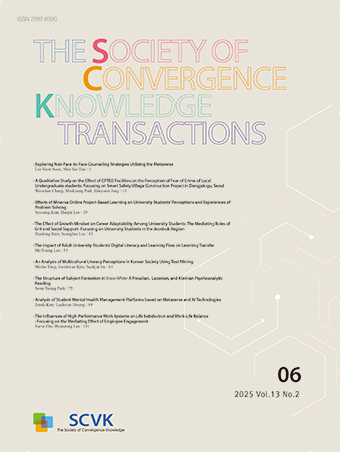Research Article
Abstract
References
Information
H.Markowitz의 평균-분산 framework을 기초로 하는 기존의 포트폴리오 이론에서는 펀드 작성시의 목적함수는 위험의 최소화이며, 제약 조건은 일정 수준의 목표 수익이 되며, 펀드에 편입되는 종목은 사전에 주어져 있고, 각 종목의 편입 비율만 결정되는 형태이다. 그러나 종목 선택의 관점에서 펀드 작성은 조합 최적화 문제로 귀착된다. 즉, 조합 최적화 문제에서는 모든 해를 열거하고, 그 중에서 가장 최적인 해를 선택하는 것이 이상적이다. 실제로는 문제의 규모와 함께 조사하여야 하는 해의 개수가 급격히 증가하므로, 계산기로는 엄밀한 최적해를 발견한다는 것이 불가능하다. 펀드 작성은 조합 최적화 문제이며 그 최적해를 탐색하는 방법으로 유전적 알고리듬을 사용한다. 유전적 알고리듬은 자연계의 교차, 도태, 돌연변이를 컴퓨터로 실행하는 것으로 최적화 문제 중에서도 조합 최적화 문제에 효과적인 방법이다. 지금까지 대부분의 다목적 최적화는 목적함수의 1차원화와 단목적 최적화의 반복에 의하여 해를 구하였지만, 본 연구에서는 유전적 알고리듬이 복수의 해 후보 집단을 구성하는 것을 이용하여 파레토 최적해 집단을 직접 찾는다는 점이 다르다. 또한 유전적 알고리듬을 사용하여 기존 펀드의 재조정도 가능하다. 더 나아가 평가 함수의 변경이나 재조정 방법을 개량하면 좀더 발전된 결과를 얻을 수 있다.
In the traditional portfolio theory based on H.Markowitz's mean-variance framework, the objective function in fund structuring is the minimization of risk, the constraints become the target return at a certain level, the stocks incorporated into the fund are given in advance, and only the proportion of stocks' inclusion is determined. However, in terms of stock selection, the fund structuring comes down to the combinatorial optimization problem. In other words, it is ideal to choose the optimal solution by enumerating all solutions in the combinatorial optimization problem. In reality, with the scale of the problem, the number of solutions to be investigated increases dramatically, so it is impossible for calculators to find a rigorous optimal solution. Fund structuring is a combinatorial optimization problem and genetic algorithms are used as a way to search for the optimal solution. The genetic algorithm is an effective method for combinatorial optimization problem among the optimization problems by executing the crossover, selection and mutation of the natural systems by computer operations. Many conventional multi-objective optimization techniques have solved the problem by one-dimensional optimization of the objective function and repetition of the single-objective optimization. In this study, however, the pareto optimal solution group is directly obtained by using the genetic algorithm constituting a plurality of solution candidate groups is different. It is also possible to rebalancing existing funds using genetic algorithms. Furthermore, by improving the method of changing or re-adjusting the evaluation function, more advanced results can be obtained.
- J.J.Grefenstette, “Optimization of control parameters for genetic algorithms,” IEEE Transactions on Systems, Man, and Cybernetics, Vol.16, No.1, pp.122-128, 1986.10.1109/TSMC.1986.289288
- H.Tamaki and Y.Nishikawa, “A parallel genetic algorithm based on a neighborhood model and its application to the jobshop scheduling,” in Parallel Problem Solving from Nature, 2, North-Holland, Amsterdam, pp.573-582, 1992.
- D.Daude, et al., “Neutral Genetic Drift-Based Engineering of a Sucrose-Utilizing Enzyme toward Glycodiversification,” ACS Catalysis Vol.9, No.2, pp.1241-1252, 2019.10.1021/acscatal.8b03609
- 坂和正敏, 非線形システムの最適化<一目的から多目的へ>, 森北出版, 1986.
- 茨木俊秀, 離散最適化とアルゴリズム,岩波講座․応用數学:方法8, 1993.
- K.A.De Jong, An Analysis of the Behavior of a Class of Genetic Adaptive Systems, Doctoral dissertation, University of Michigan, pp. 136-148, 1975.
- D.E.Goldberg and J.Richardson, “Genetic algorithms with sharing for multimodal function optimization,” in Proceedings of the Second International Conference on Genetic Algorithms, Lawrence Erlbaum Associates, Hillsdale, NJ, pp.41-49, 1987.
- X.Yin and N.Germay, “A fast genetic algorithm with sharing scheme using cluster analysis methods in multimodal function optimization,” in Artificial Neural Nets and Genetic Algorithms, Proceedings of the International Conference in Innsbruck, Austria, Springer-Verlag, Wien, pp.450-457, 1993.10.1007/978-3-7091-7533-0_65
- 高林章夫, “遺伝的アルゴリズムによるファンド作成とリバランス,” 1995 冬季大會豫告集, 日本金融․證券計量․工学学會, pp.37-46, 1995.
- 靑木博明, “遺伝的アルゴリズムによる効率的フロンティアの導出,” 情報科学硏究, Vol.17, pp.19-34, 2003.10.1260/095745603322986065
- 萩原大地, “インスタンスベース政策最適化による市場の狀態変化を考慮したポートフォリオのリバランス,” 電氣学會論文誌C, Vol.136, No.3, pp.415-422, 2016.10.1541/ieejeiss.136.415
- Publisher :The Society of Convergence Knowledge
- Publisher(Ko) :융복합지식학회
- Journal Title :The Society of Convergence Knowledge Transactions
- Journal Title(Ko) :융복합지식학회논문지
- Volume : 7
- No :2
- Pages :25-32
- DOI :https://doi.org/10.22716/sckt.2019.7.2.022




 The Society of Convergence Knowledge Transactions
The Society of Convergence Knowledge Transactions







